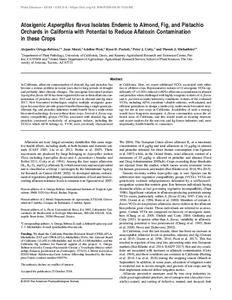| dc.contributor.author | Ortega-Beltran, A. |
| dc.contributor.author | Moral, J. |
| dc.contributor.author | Picot, A. |
| dc.contributor.author | Puckett, R.D. |
| dc.contributor.author | Cotty, P.J. |
| dc.contributor.author | Michailides, T.J. |
| dc.date.accessioned | 2019-12-04T11:30:18Z |
| dc.date.available | 2019-12-04T11:30:18Z |
| dc.date.issued | 2019-02-25 |
| dc.identifier.citation | Ortega-Beltran, A., Moral, J., Picot, A., Puckett, R.D., Cotty, P.J. & Michailides, T.J. (2019). Atoxigenic Aspergillus flavus isolates endemic to almond, fig, and pistachio orchards in California with potential to reduce aflatoxin contamination in these crops. Plant Disease, 1-8. |
| dc.identifier.issn | 0191-2917 |
| dc.identifier.uri | https://hdl.handle.net/20.500.12478/5252 |
| dc.description.abstract | In California, aflatoxin contamination of almond, fig, and pistachio has become a serious problem in recent years due to long periods of drought and probably other climatic changes. The atoxigenic biocontrol product Aspergillus flavus AF36 has been registered for use to limit aflatoxin contamination of pistachio since 2012 and for use in almond and fig since 2017. New biocontrol technologies employ multiple atoxigenic genotypes because those provide greater benefits than using a single genotype. Almond, fig, and pistachio industries would benefit from a multi-strain biocontrol technology for use in these three crops. Several A. flavus vegetative compatibility groups (VCGs) associated with almond, fig, and pistachio composed exclusively of atoxigenic isolates, including the VCG to which AF36 belongs to, YV36, were previously characterized in California. Here, we report additional VCGs associated with either two or all three crops. Representative isolates of 12 atoxigenic VCGs significantly (P < 0.001) reduced (>80%) aflatoxin accumulation in almond and pistachio when challenged with highly toxigenic isolates of A. flavus and A. parasiticus under laboratory conditions. Isolates of the evaluated VCGs, including AF36, constitute valuable endemic, well-adapted, and efficient germplasm to design a multi-crop, multi-strain biocontrol strategy for use in tree crops in California. Availability of such a strategy would favor long-term atoxigenic A. flavus communities across the affected areas of California, and this would result in securing domestic and export markets for the nut crop and fig farmer industries and, most importantly, health benefits to consumers. |
| dc.description.sponsorship | California Pistachio Research Board |
| dc.description.sponsorship | Almond Board of California |
| dc.description.sponsorship | Consejo Nacional de Ciencia y Tecnologıá, Peru |
| dc.description.sponsorship | H2020 Marie Skłodowska-Curie Actions |
| dc.format.extent | 1-8 |
| dc.language.iso | en |
| dc.rights | Copyrighted; all rights reserved |
| dc.subject | Aflatoxins |
| dc.subject | California |
| dc.subject | Aspergillus Flavus |
| dc.subject | Almonds |
| dc.subject | Figs |
| dc.subject | Pistachios |
| dc.title | Atoxigenic Aspergillus flavus isolates endemic to almond, fig, and pistachio orchards in California with potential to reduce aflatoxin contamination in these crops |
| dc.type | Journal Article |
| dc.description.version | Peer Review |
| cg.contributor.crp | Agriculture for Nutrition and Health |
| cg.contributor.affiliation | International Institute of Tropical Agriculture |
| cg.contributor.affiliation | University of California |
| cg.contributor.affiliation | University of Arizona |
| cg.coverage.region | Acp |
| cg.coverage.region | Central America |
| cg.coverage.country | United States |
| cg.researchtheme | PLANT PRODUCTION & HEALTH |
| cg.isijournal | ISI Journal |
| cg.authorship.types | CGIAR and advanced research institute |
| cg.iitasubject | Aflatoxin |
| cg.iitasubject | Plant Diseases |
| cg.iitasubject | Plant Health |
| cg.iitasubject | Plant Production |
| cg.journal | Plant Disease |
| cg.howpublished | Formally Published |
| cg.accessibilitystatus | Limited Access |
| local.dspaceid | 103573 |
| cg.targetaudience | Scientists |
| cg.identifier.doi | https://dx.doi.org/10.1094/PDIS-08-18-1333-RE |

